Architecture of Normandy
- See also the Romanesque architecture erected by the Normans at Norman architecture.

The architecture of Normandy spans a thousand years.
Vernacular domestic styles
In Haute-Normandie and in pays d'Auge, Mortainais, Passais and Avranchin (Basse-Normandie),[1] the vernacular domestic architecture is typically half-timbered and thatched.
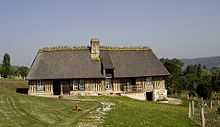
The half-timbered farmhouses scattered across the countryside are inherited of an older tradition that finds its root in the Celtic farms, whose remains were excavated by the archeologists. A particular style of farm enclosure clos masure or cour-masure has developed in the Pays de Caux as a result of the harsher landscape of that area and a local tradition, that has been influenced by the English and Danish design.
Brick and flintstone are later used to build or to rebuild a part of the cottages and official monuments (town halls, etc.). Villages of the pays de Caux and pays de Bray were entirely rebuilt this way.
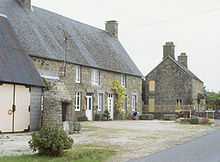
The other parts of Basse-Normandie, especially the Cotentin Peninsula, tends to use granite, the predominant local building material. The Channel Islands also share this influence - Chausey was for many years a source of quarried granite, including for the construction of Mont Saint-Michel. The Caen plain and the Bessin use the traditional limestone, called Caen stone.
Urban vernacular style
Like almost everywhere in France, the oldest houses in the main cities are half-timbered, but there are more widespread in Haute-Normandie and there are more recent examples.
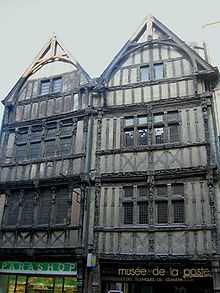
Unfortunately the urban architectural heritage of mainland Normandy was badly damaged during the Battle of Normandy in 1944. Many historic urban centres were destroyed, notably in Caen, Rouen, Lisieux and perhaps most tragically in Valognes, once known as the Versailles of Normandy for its aristocratic mansions and palaces. Massive post-war urban reconstruction in 1950s and 1960s, such as in Le Havre and Saint-Lô, has left modernist interventions.
Ecclesiastical architecture
The confident ecclesiastical architecture, such as at Lessay and Bayeux, has left its mark on the landscape, as well as an artistic legacy in literature and in art, for example Claude Monet's series of impressionist paintings of the Gothic facade of Rouen Cathedral.
- Abbey of Jumièges, near Rouen (ruins)
- Abbey of Mont Saint-Michel, Normandy (continued in Gothic style)
- Abbey of Bec
- Two abbeys at Caen founded by William the Conqueror
Fin de siècle architecture in Normandy
The south part of Bagnoles-de-l'Orne, which is called "Belle Époque" district is filled with superb bourgeois villas with polychrome façades, bow windows and unique roofing. This area, built between 1886 and 1914, has an authentic "Bagnolese" style and is typical of high-society country vacation of the time.
Gallery
References
- ↑ Jean-Louis Boithias et Corinne Mondin La maison rurale en Basse-Normandie, éditions Créer, 63 340 Nonette. p. 15.


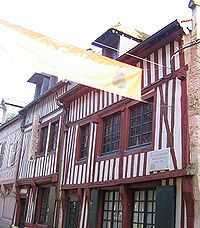








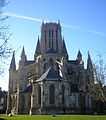

_Maison_natale_1.jpg)